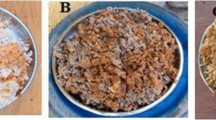Abstract
Gundruk is a fermented leafy vegetable and khalpi is a fermented cucumber product, prepared and consumed in the Himalayas. In situ fermentation dynamics during production of gundruk and khalpi was studied. Significant increase in population of lactic acid bacteria (LAB) was found during first few days of gundruk and khlapi fermentation, respectively. Gundruk fermentation was initiated by Lactobacillus brevis, Pediococcus pentosaceus and finally dominated by Lb. plantarum. Similarly in khalpi fermentation, heterofermentative LAB such as Leuconostoc fallax, Lb. brevis and P. pentosaceus initiated the fermentation and finally completed by Lb. plantarum. Attempts were made to produce gundruk and khalpi using mixed starter culture of LAB previously isolated from respective products. Both the products prepared under lab condition had scored higher sensory-rankings comparable to market products.
Similar content being viewed by others
References
Tamang JP, Tamang B, Schillinger U, Franz CMAP, Gores M and Holzapfel WH (2005) Identification of predominant lactic acid bacteria isolated from traditional fermented vegetable products of the Eastern Himalayas. Int. J Food Microbiol 105:347–356
Holzapfel WH, Giesen R, Schillinger U and Lücke FK (2003) Starter and protective cultures. In: Food Preservatives, 2nd edition (Eds. Russell NJ, Russell and Gould GW), pp 291–319. Kluwer Academic/Plenum Publishers, New York
Akbudak B, Ozer MH, Uylaser V and Karaman B (2007) The effect of low oxygen and high carbon dioxide on storage and pickle production of pickling cucumbers cv. ‘Octobus’. J Food Eng 78(3):1034–1046
Martinez-Sanchez A, Allende A, Bennett RN, Ferreres F and Gil MI (2006) Microbial, nutritional and sensory quality of rocket leaves as affected by different sanitizers. Postharvest Biology and Technol 42(1):86–97
Xu W, Qu W, Huang K, Guo F, Yang J, Zhao H and Luo Y (2007) Antibacterial effect of grapefruit seed extract on food-borne pathogens and its application in the preservation of minimally processed vegetables. Postharvest Biology and Technol 45(1):126–133
Settanni L and Corsetti A (2008) Application of bacteriocins in vegetable food preservation. Int J Food Microbiol 121(2): 123–138
Holzapfel WH (2002) Appropriate starter culture technologies for small-scale fermentation in developing countries. Int J Food Microbiol 75:197–212
Tamang B (2006) Role of lactic acid bacteria in fermentation and biopreservation of traditional vegetable products. Ph. D. Thesis, Sikkim Government College (under North Bengal University), Gangtok. pp. 274
AOAC (1990) Official Methods of Analysis, 15th edition. Association of Official Analytical Chemists, Virginia
Meilgaard M, Civille GV and Carr BT (1990) Sensory Evaluation Techniques. CRC Press, Florida
Han BZ, Beumer RR, Rombouts FM and Nout MJR (2001) Microbiological safety and quality of commercial sufu- a Chinese fermented soybean food. Food Control 12:541–547
Schillinger U and Lücke FK (1987) Identification of lactobacilli from meat and meat products. Food Microbiol 4: 199–208
Dykes GA, Britz TJ and von Holy A (1994) Numerical taxonomy and identification of lactic acid bacteria from spoiled, vacuum packaged Vienna sausages. J Appl Bacteriol 76: 246–252
Tamang JP, Dewan S, Thapa S, Olasupo NA, Schillinger U and Holzapfel WH (2000) Identification and enzymatic profiles of predominant lactic acid bacteria isolated from softvariety chhurpi, a traditional cheese typical of the Sikkim Himalayas. Food Biotechnol 14(1–2):99–112
Simpson WJ and Taguchi H (1995) The genus Pediococcus, with notes on the genera Tetragenococcus and Aerococcus. In: The Genera of Lactic Acid Bacteria (Eds. Wood BJ and Holzapfel WH), pp 125–172. Blackie Academic and Professional, London
Wood BJB and Holzapfel, WH (1995) The Lactic Acid Bacteria, vol. 2: The Genera of Lactic Acid Bacteria. Blackie Academic and Professional, London
Kurtzman CP and Fell JW (1998) The Yeast, A Taxonomic Study, 4th edition. Elsevier Science, Amsterdam
Snedecor GW and Cochran WG (1989) Statistical Methods, 8th edition. Iowa State University Press, Ames, IA, USA
Lu Z, Fleming HP and McFeeters RF (2001) Differential glucose and fructose utilization during cucumber juice fermentation. J Food Sci 66(1):162–166
Adams MR and Nicolaides L (1997) Review of the sensitivity of different foodborne pathogens to fermentation. Food Control 8(5/6):227–239
Fernandez Gonzalez MJ, Garcia P, Garrido Fernandez A, and Duran Quintana MC (1993) Microflora of the aerobic preservation of directly brined green olives from Hojiblanca cultivar. J Appl Bacteriol 75(3):226–233
Harris LJ (1998) The microbiology of vegetable fermentations. In: Microbiology of Fermented Foods, vol. 1 (Ed. Wood BJB) pp. 45–72. Blackie Academic and Professional, London
McDonald LC, Fleming HP and Daeschel MA (1991) Acidification effects on microbial populations during initiation of cucumber fermentation. J Food Sci 56(5): 1353–1359
Eom H-J, Seo DM and Han NS (2007) Selection of psychrotrophic Leuconostoc spp. producing highly active dextransucrase from lactate fermented vegetables. Int J Food Microbiol 117(1):61–67
Gardner NJ, Savard T, Obermeier P, Caldwell G and Champagne CP (2001) Selection and characterization of mixed starter cultures for lactic acid fermentation of carrot, cabbage, beet and onion vegetable mixtures. Int J Food Microbiol 64(3):261–275
Oguntoyinbo FA, Sanni AI, Franz CMAP and Holzapfel WH (2007) In vitro fermentation studies for selection and evaluation of Bacillus strains as starter cultures for the production of okpehe, a traditional African fermented condiment. Int J Food Microbiol 113(2):208–218
Tamang B., Tamang JP, Schillinger U, Franz CMAP, Gores M and Holzapfel WH (2008) Phenotypic and genotypic identification of lactic acid bacteria isolated from ethnic fermented tender bamboo shoots of North East India. Int J Food Microbiol 121:35–40
Tamang JP, Dewan S, Tamang B, Rai A, Schillinger U and Holzapfel WH (2007) Lactic acid bacteria in Hamei and Marcha of North East India. Indian J Microbiol 47(2): 119–125
Author information
Authors and Affiliations
Corresponding author
Rights and permissions
About this article
Cite this article
Tamang, B., Tamang, J.P. In situ fermentation dynamics during production of gundruk and khalpi, ethnic fermented vegetable products of the Himalayas. Indian J Microbiol 50 (Suppl 1), 93–98 (2010). https://doi.org/10.1007/s12088-010-0058-1
Received:
Accepted:
Published:
Issue Date:
DOI: https://doi.org/10.1007/s12088-010-0058-1




